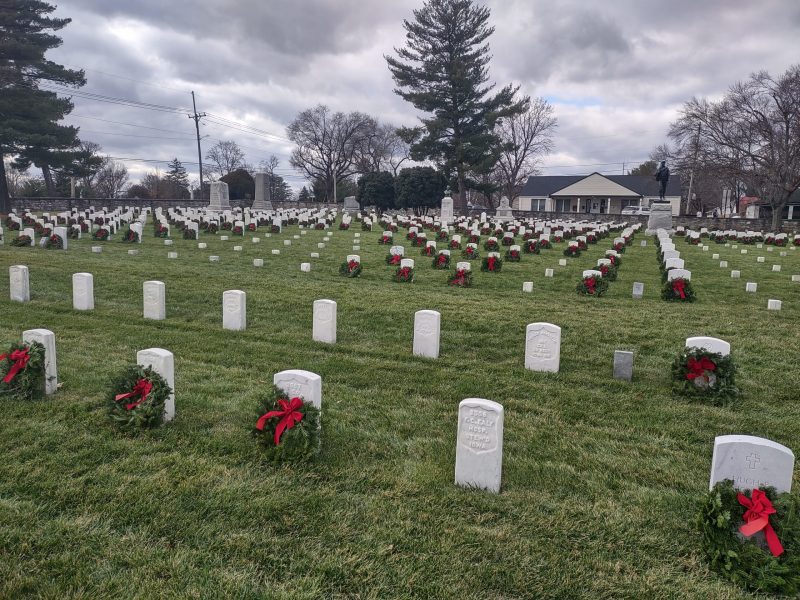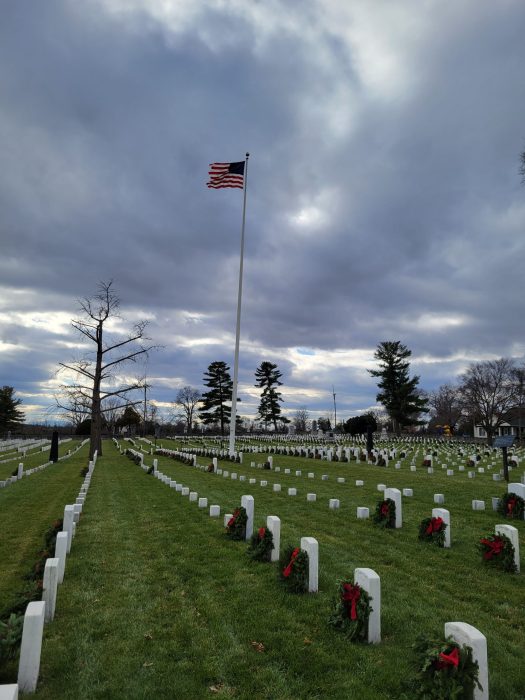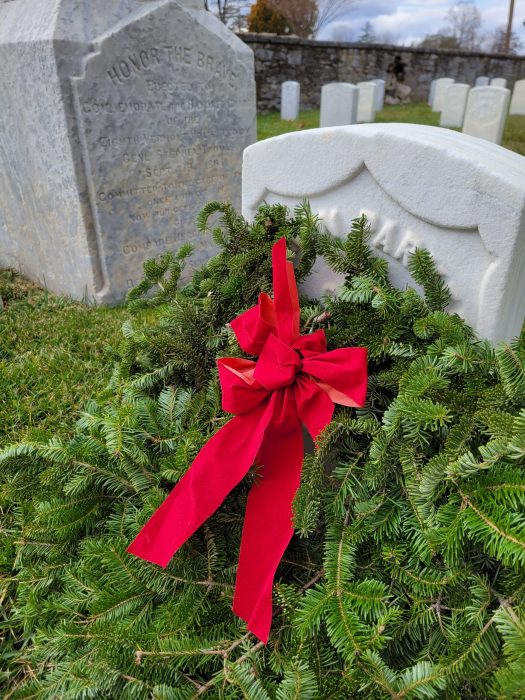Reflections: 2022 Wreaths Across America—Winchester National Cemetery

Winchester National Cemetery holds just over 5,500 interments, of which around 4,400 are United States soldiers that served during the Civil War. These include soldiers who perished in combat, died of their wounds, or passed due to disease within the Lower Shenandoah Valley, recovered postwar from a 40-mile radius, including Kernstown, Cedar Creek, Harpers Ferry, and Winchester itself.
Earlier this year, Emerging Civil War hosted a fundraiser and donated gifts for 60 wreaths to join the hundreds of others for the Wreaths Across America event at Winchester National Cemetery. Wreath Across America, a 501c3 nonprofit, coordinates the creation and placement of evergreen wreaths with red bows on the graves of U.S. military veterans in cemeteries across all 50 states. The wreath laying is typically held on the third Saturday of December with wreaths laid at 12noon Eastern Standard Time, to reflect the beginning of the tradition at Arlington National Cemetery.
This year Jon Tracey and Sarah Kay Bierle quietly represented Emerging Civil War at Wreaths Across America at Winchester National Cemetery and got to help place some of the 60 wreaths that ECW “sent.” Following are some of their reflections from the event:
Jon Tracey
Each year, wreaths honoring each branch of service are placed in the cemetery. Passing them, I could not help but notice the inclusion of the most recent branch: the United States Space Force. Though Winchester National Cemetery holds burials of service members from conflicts through Afghanistan, the vast majority of the burials are soldiers who died during the Civil War. I could not help but wonder what those men, whose closest exposure to the Air Force or Space Force might have been witnessing Thaddeus Lowe’s wartime Balloon Corps, would think about how the armed forces have changed in the past 160 years.

Winchester National Cemetery occupies a unique space, both geographically and symbolically. Though located in the northern portion of the Shenandoah Valley, no one can doubt that the majority of white citizens were supporters of the Confederate cause. However, because of that strategic location the town often played host to United States military forces for extended periods of time. Unlike other places, Union veterans visiting the Shenandoah Valley often chose to place their regimental monument with their comrades here in the National Cemetery rather than the unpreserved battlefields. Thus, the cemetery is not only a resting place for those who fell during the war, but a place of remembrance of their cause—an icon of Civil War memory and Unionism.

In the 1890s, a man named E. M. Houston was among those thinking of Winchester National Cemetery as a symbol of Union. He had served with a New York regiment during the war and moved to the area later on, and was an active member of the local Grand Army of the Republic post with other local US veterans. The small post received little support from other Winchester residents or from fellow veterans elsewhere, and in 1892 he appealed for help to decorate the cemetery for Memorial Day, writing: “With our few in number the burden of responsibility upon us in the South is a tax more than we feel able to assume…most remain quiet or deaf to the appeals from the mounds where underneath lie those who shared their hardships.”
Though Houston did rally support from other regional veterans that decade and many came by train to help, it is a reminder of the continued necessity to remember. That support wasn’t taken for granted by the veterans themselves, and it shouldn’t be now. We can honor that in many different ways and on many different days – it doesn’t have to be done with a wreath on the third Saturday in December. It can be reading their name, it can be researching and sharing their stories, it can be visiting or helping to preserve a battlefield they fought on. It can be dedicating ourselves to the unfinished work for which they gave the last full measure of devotion. And, of course, it can be donating or placing a wreath. But, we should make that effort in what ways we can.

Sarah Kay Bierle
As always, the Wreaths Across America ceremony and volunteer opportunity offered moments for meaningful reflection about the soldiers of the past and why I am committed to public history. This year it was especially thought-provoking to be able to place wreaths on the headstones of soldiers that we had researched and that you — our readers and fundraiser donors — helped to honor. Thank you.

For the first time that I can remember, I stopped and watched a family reading what Union veterans had left inscribed on a monument. They read about a regiment that fought at Third Winchester. I heard the parents guess “that was during the Civil War” as they made an effort to explain to the young children. The youngsters bobbed around at first, then paused and listened. Perhaps a seed of interest had been planted.
The red ribbons on the evergreens always seem to need a little straightening after their transport journey. I always do this on “my” wreaths before placing them, but as time passed, and we walked slowly back along the rows, I kept pausing to “fix” the bows and ribbons that looked especially crushed. I know it doesn’t really make a difference whether that ribbon is crinkled or if the bow is “fluffed,” but as I reached toward one particularly messy one, I thought about how in the general sense of a stereotype, women fixate on the details. “It has to be just so.” A commonality across the centuries? Something in the moment of straightening the velvet-like ribbon made me think of reaching out to straighten something on a uniform. A tender gesture that many a mother, sister, wife, or sweetheart might have made when seeing their boy or man in uniform. Was that the last time a woman “fussed” over something connected to appearance? The soldiers in blue buried in Winchester National Cemetery died far from their homes and loved ones. They are in this cemetery—this place of honor—because their families did not or could not bring their remains home. So, maybe it’s just the aesthetics of wanting to straighten the ribbons. Or maybe there is something more in taking that extra few seconds, to pause, to reach and fix gently, to remember.

Moving from the rows of graves and returning toward the halted crowd near the entrance to the cemetery, Jon and I realized the ceremony of wreath laying, short speeches, and military music had begun. We stopped, in a sort of silent no-man’s-land. The tall, central flagpole stood between us and the crowd who had now turned toward the raised banner for whatever was coming next. We could not hear the directions from the speaker, but the notes from the bugle were unmistakable: Taps. As the long bugle notes echoed the benediction dating back to 1862, other gentle sounds joined the quiet. Perhaps unheard in the crowd, but clear where we had stopped in awkwardly respectful isolation. Above, the tether hooks of the flag chattered rhythmically in the wind against the large metal pole. Yes, the Star-Spangled Banner yet waves—I thought—because of those in this cemetery and thousands more who sacrificed at other places and in other eras. Another sound joined strain of the bugle and the soft beat of the metal: bells. Somewhere in Old Town Winchester, bells tolled the midday hour. Something for the past, the present, and the future…all twined together in an audible moment.
When all was concluded, still we lingered—as if struggling to tear ourselves away from the men and boys we had come to know through the pages of research, and the ones whose names had been left on slips of paper or in shared digital files “to research later.” Perhaps the scene before us represented meaning. What it means to come and honor sacrifice. What it means and why it matters to research, share, and teach accurately about these who fought before.
The concluding words from Dr. James I. Robertson, Jr.’s book Soldiers Blue and Gray came to mind: “Thousands of those men who loved America…lie beneath orderly rows of gleaming white headstones. A Regular Army officer of that day might snort that at last those damned volunteers were in a straight formation…. And yet, beneath those stones is the simple reminder—and the lasting realization—that when the great challenges come, this nation’s common people can and will show that they value some ideals more than they value their lives.”
And finally, we had to leave them. The gravestones covered with wreaths. The dead sleeping on, unaware and unknowing. But we know, we see, we remember them.

Beautifully done. Thank you for your service in this manner.
Thank you both for your commitment and reminding us what this country is made of. The sacrifices are unimaginable but need to be remembered daily. Your work & devotion keeps history alive.
I am 750 miles away in Maine, yet this post is so well written that I walk through the Winchester National Cemetery, as I read it